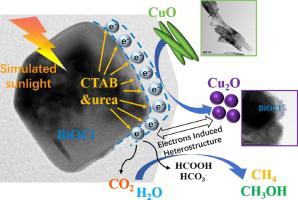Applied Surface Science ( IF 6.3 ) Pub Date : 2022-01-15 , DOI: 10.1016/j.apsusc.2022.152463 Yang Song 1 , Caichao Ye 2, 3 , Xue Yu 4 , Jiayu Tang 4 , Yunxia Zhao 4 , Wei Cai 4

|
To help China achieve its goal of carbon neutrality, a CuO/BiOCl heterostructure with enhanced electron-induced interfacial interactions and improved CO2 photoreduction performance was hydrothermally synthesized in situ. The electrons originating from the surface residual CTAB & urea reacted with the CuO component to generate Cu2O, and between them BiOCl played the bridged role to transfer the electrons, which strengthened the intense contact between the two components, thus harvesting light and promoting the segregation and transfer efficiency of the photogenerated carriers. Furthermore, the greater number of generated electrons could enhance the activation of CO2, which could decrease the energy barriers of the thermodynamically stable CO2 and especially promote the formation of CO2-reduced intermediates (HCOOH, HCO3–). As a result, the CO2 photoreduction performance of the electron-induced heterostructure of CuO/BiOCl composites exhibited higher CH4 and CH3OH yields than neat CuO or BiOCl, in which the optimized BC2 photocatalyst (2% mass ratio of CuO to BiOCl) reached 114.1 μmol·h−1·g−1 CH4 and 36.2 μmol·h−1·g−1 CH3OH. This work provided a new strategy to synthesize efficient heterojunctions that can improve the photocatalytic reduction of CO2; these heterojunctions were constructed with a strong interaction interface via self-electron-reduction.











































 京公网安备 11010802027423号
京公网安备 11010802027423号